Alexandria Egyptian
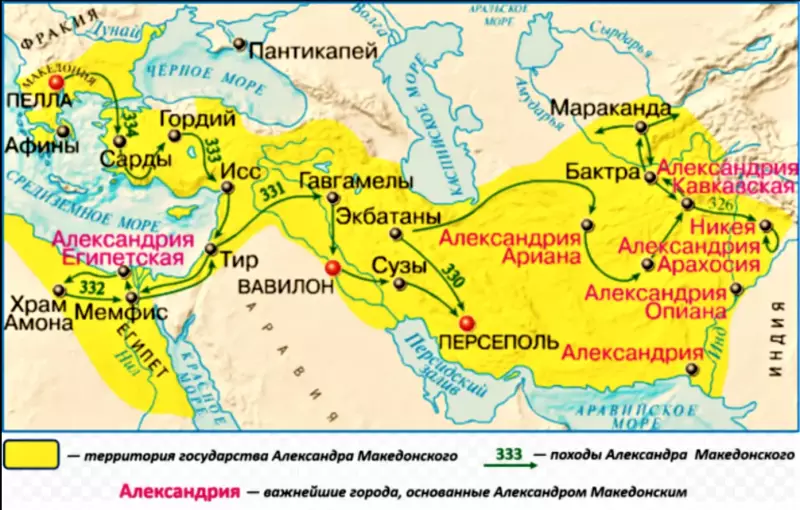
Alexander the Great's march to the east.
Base
The city, which became the personification of Hellenism [1], was founded by the Macedonian king Alexander III (336–323 BC) in 332 BC. e. on the site of the ancient Egyptian settlement of Rakotida/Rakotis [2] during his campaign to the east in general and against the Persians in particular. Later, the city was also called Alexandria Magna (Alexandria the Great), in contrast to the city of Alexandria Minor (Alexandria Minor) [3], later known as Alexandretta [4]. Ancient, that is, pre-Islamic, Alexandria entered the history called "Alexandria of Egypt".
King Alexander entrusted the construction of Alexandria to his appointed nomarch/satrap Cleomenes [5], a Greek from the city of Naucratis, a Greek colony located approximately 80 km southeast of the site of the new Greek city. The plan for the long-term regular (Hippodamian [6]) development of the city [7] was drawn up by the architect Deginocrates/Deinocrates/Dinocrates/Dinochars [8]. Alexandria had all the attributes of a large Greek city: gymnasium, stadium, theater, hippodrome [9], etc. At first, the most important temple of pagan Alexandria was the temple of Poseidon, later - the temple of Serapis [10] (Serapeion/Serapium) [11].
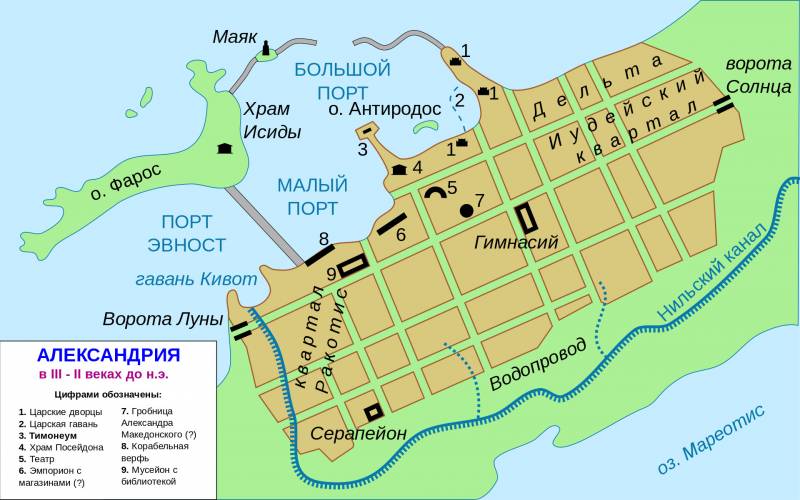
Plan of ancient Alexandria.
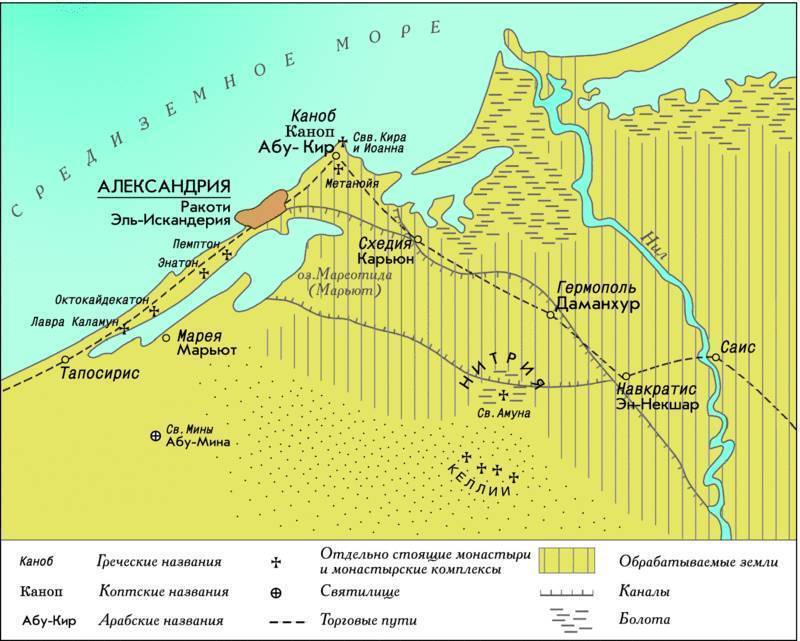
The outskirts of Alexandria in ancient times.
After much vicissitudes [12], the body of its founder [13] rested in the city after his death in Babylon in 323 BC. e. “Alexander’s tomb, according to sources (Strab., XVII, 8), was located in the center of the city on the territory of the palace complex. Subsequently, as Zenobius reports, a sophist of the 94nd century AD. e., Ptolemy IV Philopator built a mnema in the center of the city, which is now called Sema, where he placed all his predecessors, including Alexander the Great (Zenob., III, XNUMX).
Thus, from this time, namely: from the end of the 14rd century BC. e. The Ptolemies began to rest next to Alexander, and their burials represented a dynastic complex” [XNUMX].
Back in 30 BC. e. the future emperor Octavian Augustus saw the sarcophagus and body of Alexander the Great [15]. However, the coffin that the first Roman emperor saw was not the same golden sarcophagus where the body of Alexander the Great was laid to rest under the care of the diadochos Ptolemy, the future king Ptolemy I Soter (305–283 BC) [16], in 322 BC . e., but “from transparent stone”, since the golden sarcophagus was stolen by King Ptolemy X Alexander I (107–89 BC) in the last year of his reign [17].
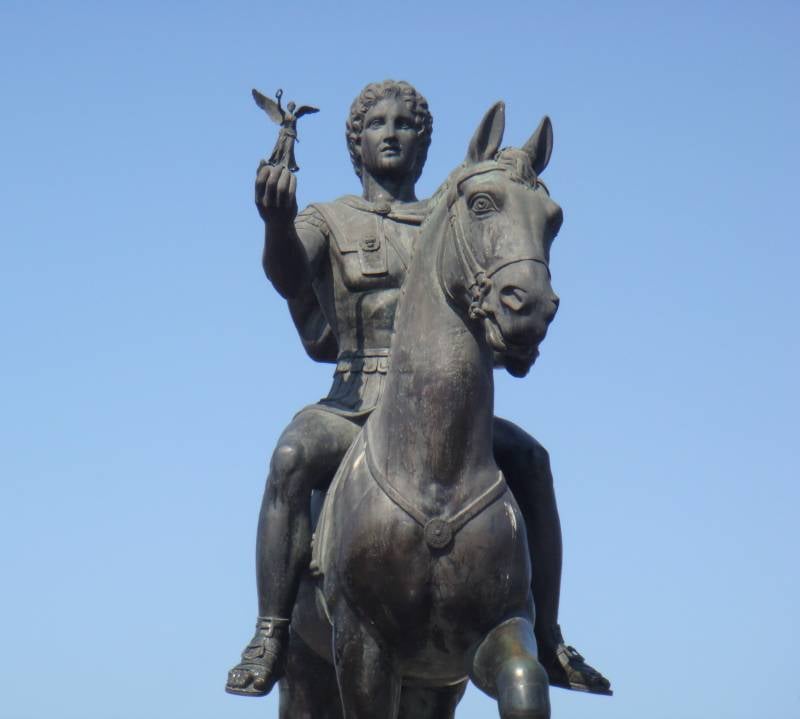
Modern monument to Alexander the Great in Alexandria. Photo by the author.
Capital of Egypt
Under the Hellenistic Lagid[18]/Ptolemaic dynasty (323–30 BC), Alexandria from 311 BC. e. [19] was the capital of Egypt [20] and the center of Hellenistic culture, whose population in different years reached more than half a million people [21].
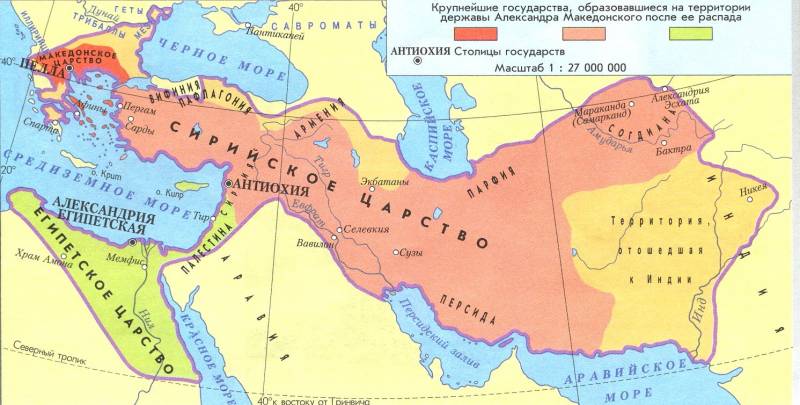
The collapse of the power of Alexander the Great.
The city, in addition to the Macedonians and Greeks, was inhabited by Jews:
Alexandria developed rapidly thanks to trade.
The seaport was huge and conventionally divided into Big and Small. In addition, there was a port on the shores of Lake Mareotis, which surrounds the city from the south. This port was connected by a canal to the Nile, which was connected by the “Pharaonic Canal” (in the Roman era - “Trajan’s River”) with the Red Sea. That is, Alexandria was the main city on the shortest route from the Mediterranean Sea to the Indian Ocean [24].
There is an opinion about the predominance of land trade over sea trade in the trade of Hellenistic Egypt with India:
Economically, Alexandria played an important role as a food hub, primarily for the export of grain produced in Egypt [26]. Thus, the social stability of the Roman Empire depended on the supply of Egyptian bread (here it is appropriate to recall the main demands of the Roman plebs - “bread and circuses”) and, one might say, its survival [27].
To improve navigation conditions in 299–279. BC e. The architect Sostratus of Knidos built the famous 28-meter Pharos or Alexandria Lighthouse [110], one of the Seven Wonders of the World, which collapsed in 29 as a result of an earthquake, on the nearby island of Pharos [1326], connected to the mainland by a dam [30].
So, having built such a structure, the builder wrote his own name on the stones inside, and then, covering it with lime, wrote on top the name of the then king, foreseeing, as it happened, that it would very soon fall along with the plaster and the inscription would be revealed: “Sostratus, son Dexifana, Cnidian, to the savior gods for the health of the sailors.”
He reckoned not with his time, but with eternity, as long as the lighthouse, a work of his art, stood” [31].
The modern word “headlight” comes from the name of the island. The lighthouse was located on the site of the 32th century fortress of Qait Bay, which has survived to this day [XNUMX].
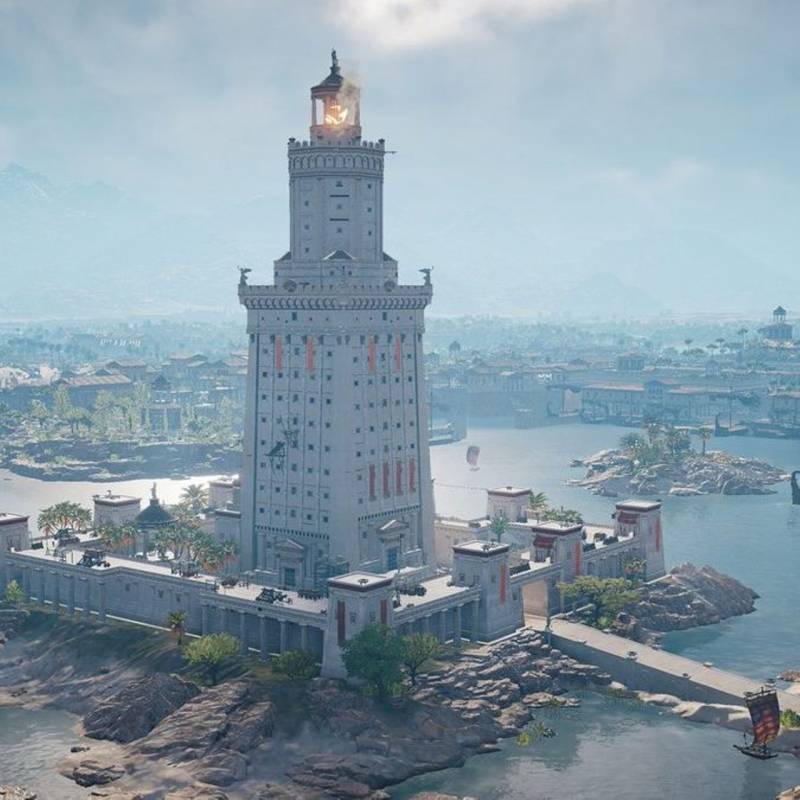
The best, in the author’s opinion, reconstruction of the Alexandria Lighthouse.
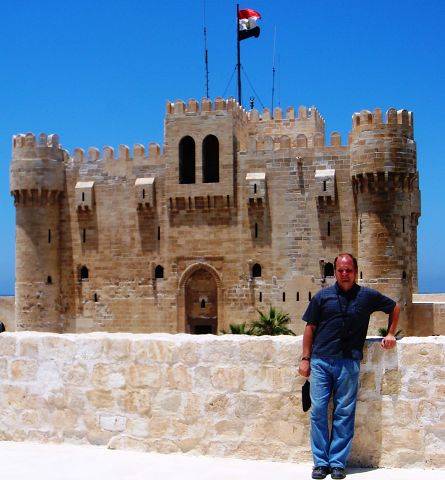
The author stands in front of the main building of the Qait Bay fortress.
Relations with Rome
As a result of Alexandria's inclusion in the Roman sphere of influence [33] and ultimately the Pax Romana, the city suffered many upheavals.
So, in 47 BC. e. During the next civil war that broke out in the Roman Republic, the Roman commander Gnaeus Pompey the Great was killed in Alexandria [34], and the city itself was occupied by the Roman army under the command of Gaius Julius Caesar. This caused an uprising of the city's inhabitants, called the "Alexandrian War". The revolt was brutally suppressed by Caesar, who is credited with the historical work of the same name [35]. During the suppression of the uprising, a fire broke out in the city, as a result of which the first collection of the Library of Alexandria was destroyed.
That is, the Library of Alexandria by the middle of the 37st century BC. e. surpassed in its collections the Antioch [38] and Pergamon [39] libraries combined [31]. In addition, in 51 BC. e. the Roman consul Mark Antony presented the Egyptian queen Cleopatra VII (30–40 BC) [41] with a significant part of the latter’s books: “he presented the Egyptian queen with the Pergamon book depositories with two hundred thousand scrolls” [XNUMX].
However, every cloud has a silver lining: as a result of these events, Caesar attracted the Alexandrian astronomer Sosigenes to reform the Roman calendar, thanks to which from January 1, 45 BC. e. In the Roman Republic, the Julian calendar was introduced, which later became widespread [42].
During the next civil war in the Roman Republic, at the Battle of Cape Actium in 31 BC. e. the combined fleet of Mark Antony and Cleopatra was defeated by fleet Roman consul Gaius Octavius, future Roman emperor Octavian Augustus (27 BC - 14 AD). In 30 BC. e. Alexandria was occupied by the Roman army under the command of Octavius [43]. Antony and Cleopatra committed suicide [44]. By order of Octavius, the Egyptian king Ptolemy XV Caesarion, the son of Cleopatra and, presumably, Caesar, was killed [45].
As a result, the Ptolemaic dynasty ceased to exist [46]. Alexandria was included in the Roman Republic, which from 27 BC. e. became an empire, and the city became the administrative center of the province of Egypt [47].
An extensive and detailed description of what Alexandria was like at the beginning of its imperial stage of existence was left by Strabo. The most interesting from this description seems to us to be the following:
The entire city is intersected by streets convenient for riding on horseback and in chariots, and by two very wide avenues, more than a plethra [49] wide, which bisect each other at right angles.
The city has beautiful sacred sites, as well as royal palaces, which make up a quarter or even a third of the entire territory of the city" [50].
And further:
Vitruvius, a contemporary of Strabo, puts Alexandria on a par with Athens and Rome [52].
Author of the XNUMXst century AD e. Josephus describes Alexandria and Egypt's position within the Roman Empire:
Alexandria sighed calmly under Emperor Hadrian (117–138), who “restored at his own expense the long-destroyed Alexandria and Jerusalem” [54].
Under Emperor Marcus Aurelius (161–180), Museion was destroyed as a result of a rebellion by the townspeople. The library continued to function under the Serapeion until 391, when it was destroyed with the permission of Emperor Theodosius, after which the Church of John the Baptist was built in its place by order of Patriarch Theophilos (385–412) [55].
Emperor Caracalla (211–217) visited Alexandria in 215 and, irritated by the townspeople’s suspicions that he had killed his own brother, carried out mass executions in the city [56].
When he appeared in the suburbs, eminent citizens came with sacred and secret relics. He [at first] welcomed them cordially and even invited them to a joint meal, [but later] killed them.
Then Antoninus brought the entire army into combat readiness and led the soldiers against the city, having previously warned all the inhabitants to stay at home, and having captured all the streets and all the roofs in advance.
In order not to describe the disasters that then befell the unfortunate city, [I will only say that] he destroyed so many of its inhabitants that he did not even dare to talk about the number of those killed, and wrote to the Senate that it did not matter which people and in what quantity died, for they all deserved such a fate. The property [of the townspeople] was either looted or destroyed. Along with the locals, a large number of visitors were killed, and many of those who arrived with Antoninus also died due to not being recognized.
The fact is that this city is large, and at the same time in all its ends people were killed both day and night, so even if you wanted to, it was impossible to recognize anyone, but people died wherever they had to, and their bodies were immediately thrown into deep ditches, so that the extent of this disaster remains hidden from others.
This is what the locals experienced.
As for the foreigners, all of them, except the traders, were expelled, and, obviously, all their property was also plundered, because even some shrines were plundered.
In all this, Antoninus himself took a rather active part, both as an observer and as a performer, and he also exercised command from the temple of Serapis, for during all these murders he spent both days and nights in this sanctuary.
While Antoninus was exterminating the Alexandrians and living in the sanctuary, he wrote to the Senate that he performed a rite of purification on the very days when he actually sacrificed animals to the god and people to himself. But is it worth talking about this if he dared to offer as a gift to God the sword with which he killed his brother?
In addition, he forbade the Alexandrians from organizing spectacles and communal meals and ordered to divide Alexandria with a wall and place guard posts along it so that the inhabitants of the city could no longer freely come to each other.
This is what the “Beast of Ausonia” [58], as he was called in the final words of the prediction given to him, did to Alexandria, which, they say, pleased him, and he was proud of such a nickname, but at the same time he killed many people for mentioning this prophecy. [59].
In 217–218 Between the emperor Marcus Opellius Macrinus (217–218) and Varius Avitus, the future emperor Marcus Aurelius Antoninus Heliogabalus/Elagabalus (218–222), a struggle for power broke out in the empire, which also affected Alexandria. Macrinus appointed Julius Basilian as prefect of Egypt, who, having learned about the proclamation of Avitus as emperor in Syria, did not obey him. In 218, after the defeat of Macrinus was reported, clashes broke out between the Roman garrison, who sided with Heliogabalus, and the inhabitants of Alexandria, who sided with Macrinus. Supporters of Heliogabalus gained the upper hand [60].
In 261, the prefect of Egypt Aemilian was proclaimed emperor by the Alexandrians. Emperor Gallienus (253–268) appointed Theodotus as the new prefect of Egypt and sent him with an army to restore control over the rebellious province. Theodotus besieged Alexandria and, after lengthy battles, captured it. The city was severely destroyed and epidemics soon began there [61].
In 273, Emperor Aurelian (270–275) defeated the supporters of Zenobia, queen of Palmyra, in Alexandria and ordered the city walls to be torn down. At the same time, the main book depository of the library was destroyed [62].
In 295, Emperor Diocletian (284–305), after an 8-month siege, suppressed the uprising of the Alexandrians and ordered the destruction of the city [63].
In memory of the capture of the city by Diocletian, Pompey's Column [65] was erected near Serapium from red granite at the beginning of the 66th century, which has survived to this day [XNUMX].
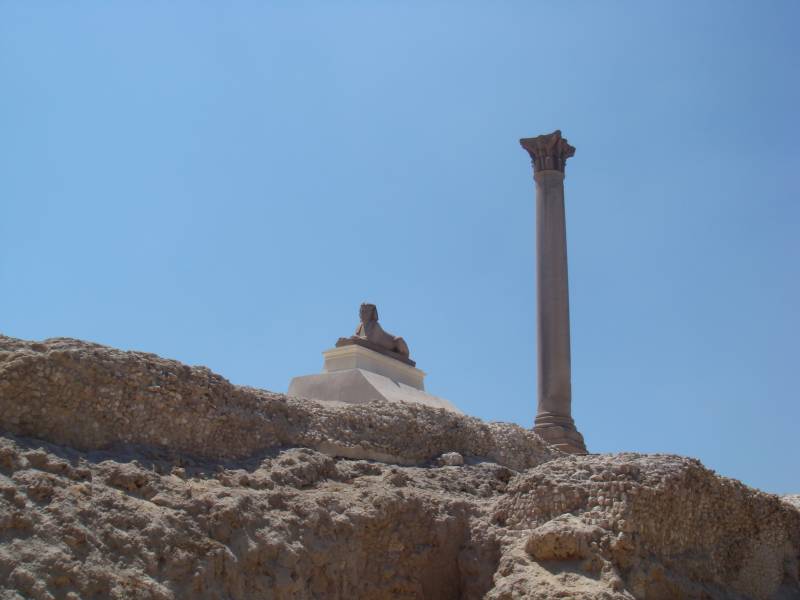
Pompey's Column. Photo by the author.
As part of the Byzantine Empire
The decline of Alexandria was exacerbated by the rise of Constantinople in the 395th century. Nevertheless, in 642–67. the city was part of the Eastern Roman (Byzantine) Empire, being the administrative center of the diocese and province of Egypt [XNUMX].
During the Byzantine-Persian War (602–628), Alexandria was attacked by the Persians in 619.
In 628, Emperor Heraclius (610–641) defeated the Persians, who, according to the treaty, returned to the Byzantines all previously captured territories [69].
In 642, the city was occupied by Arab conquerors on the basis of an agreement with Patriarch Cyrus (630–642), became part of the Arab Caliphate and became known as al-Iskandariyya.
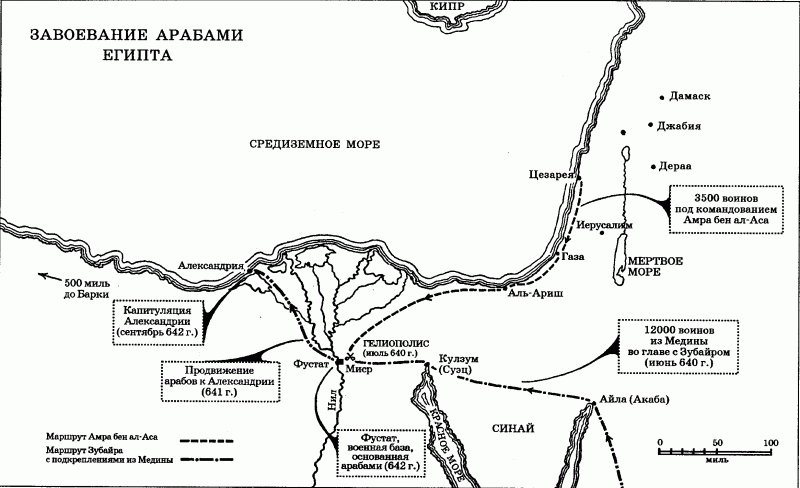
* * *
So, Alexandria as an ancient city existed for 974 years, showing the world intellectual achievements that we still use today. Having survived the political upheavals of subsequent centuries, the city still bears a glimpse of the former glory of Antiquity with its name alone.
Notes
[1] See: Tarn V. Hellenistic civilization. M., 1949; Sventsitskaya I.S. Socio-economic features of Hellenistic states. M., 1963; Shofman A. S. Collapse of the empire of Alexander the Great. Kazan, 1984; Leveque P. Hellenistic world. M., 1989; Droyzen I. History of Hellenism. In 3 vols. M.; St. Petersburg, 2003; Chernyavsky S.N. Alexander the Great and the heirs of his empire. The beginning of the era of the Diadochi. M., 2017.
[2] Of the ancient authors, Diodorus Siculus (Historical Library. XVII, 52), Quintus Curtius Rufus (History of Alexander the Great. IV, 8 (1)), Gaius Pliny Secundus the Elder (Natural History. V (XI, 62)), Plutarch (Comparative Lives. Alexander. 26) and Arrian of Nicomedia (Anabasis of Alexander. III, 1–2). Zosimus only briefly mentions this event (New History. I, 4 (2)). Cm.: Nemirovsky A. A. One Coptic legend about the founding of Alexandria: a memory two thousand years deep // Mare nostrum: the salt of the Mediterranean. Sat. Art. M., 2019.
[3] In total, Alexander the Great founded up to 20 cities called “Alexandria”. To distinguish them, some clarification was added to each name, usually geographical.
[4] Currently – Iskenderun (Türkiye).
[5] Arrian of Nicomedia. Anabasis Alexandra. III, 5 (4); Pausanias. Description of Hellas. Attica. VI, 3; Mark Yunian Justin. Epitome from the work of Pompey Trogus “Historiarum Philippicarum”. XIII, 4 (11).
[6] Named after the XNUMXth century architect. BC e. Hippodamus of Miletus.
[7] See: Castagnoli F. Orthogonal town planning in antiquity. L., 1971.
[8] See: Polyakov E. N., Drobilina Yu. A. Deinokrat - court architect of Alexander the Great // Bulletin of TGASU. 2007, no. 2; Polyakov E. N., Sukhorukova Yu. E. Alexandria of Egypt - the creation of the architect Deinocrates // Gaudeamus Igitur. 2018, No. 1.
[9] The most detailed description of Alexandria was left by Strabo (Geography. XVII (I, 6–10)), which may have been used by Ammianus Marcellinus (Acts/Roman History. XXII, 16 (7–18)). See: Architecture of the Ancient World. M., 1940, p. 412–419.
[10] Serapis is the main deity of Alexandria, whose veneration was introduced by King Ptolemy I Soter (305–283 BC), who sought to combine the features of the bull Apis and the god Osiris in the new deity. In Greek ideas, Serapis was close to Zeus, Hades and Asclepius.
[11] Pausanias. Description of Hellas. Attica. XVIII, 4; Rufinus of Aquileia. Church history. II, 23; Sozomen of Salamis. Church history. V, 3, 7.
[12] Pausanias. Description of Hellas. Attica. VI, 3; Strabo Geography. XVII (I, 8); Claudius Elian. Motley stories. XII, 64.
[13] Pausanias. Description of Hellas. Attica. VII, 1.
[14] Serova M. Yu. The cult of Alexander the Great in Alexandria of Egypt // Mnemon: Research and publications on the history of the ancient world. 2004, No. 3, p. 138.
[15] Guy Suetonius Tranquill. Biography of the Twelve Caesars. Divine August. 18; Cassius Dio Cocceianus. Roman history. LI, 16.
[16] See: Bengston G. Rulers of the Hellenistic era. M., 1982, p. 29–58.
[17] Strabo Geography. XVII (I, 8). Cm.: Saunders N. Alexander's tomb: the two thousand year obsession to find the lost conqueror. L., 2006.
[18] Lag is the father of King Ptolemy I Soter, a close associate of the Macedonian king Philip II (359–336 BC; father of Alexander the Great).
[19] Ranovich A.B. Hellenism and its historical role. M., 1950, p. 175. A. B. Ranovich does not say where the capital was moved from to Alexandria. Most likely, it was Memphis, where the body of Alexander the Great was kept until his reburial in Alexandria. Cm.: Pausanias. Description of Hellas. Attica. VII, 1.
[20] See: Percival E. Egypt under Ptolemaic rule. Foreigners who replaced the ancient pharaohs. 325–30 BC e. M., 2018.
[21] The population figure of a million people, which is often found in the literature, is clearly exaggerated. Cm.: Eine A. Alexandria the Great // VI. 1969, no. 10; Fraser P.M. Ptolemaic Alexandria. T. 1–3. Oxf., 1972; Serova M. Yu. On the issue of the polis structure of Alexandria of Egypt // Bulletin of St. Petersburg State University. Story. 2005, no. 2; Basalova N. S. Urbanization policy of the Ptolemies: social and legal composition of the population of Alexandria // Yaroslavl Pedagogical Bulletin. 2017, no. 4.
[22] Josephus Flavius. Jewish War. II, 18 (7).
[23] Ranovich A.B. Hellenism and its historical role. M., 1950, p. 208.
[24] Diodorus of Siculus. Historical library. I, 33. See: Khvostov M. Studies on the history of exchange in the era of the Hellenistic monarchies and the Roman Empire. History of eastern trade of Greco-Roman Egypt. Kazan, 1907, p. 254–351.
[25] Ranovich A.B. Hellenism and its historical role. M., 1950, p. 210.
[26] See: Belov A. A. The large port of Greco-Roman Alexandria according to modern archaeological data. // Culture of Egypt and the Mediterranean countries in antiquity and the Middle Ages. Sat. Art. M., 2009.
[27] Cornelius Tacitus reports on the secret decree of Octavinan Augustus: “Augustus, along with other secret orders during his reign, forbade senators and the most prominent of the horsemen to come to Egypt without his permission, blocked access to it, so that someone, having captured this province and the keys to it on land and at sea and holding it with any insignificant forces against a huge army, did not doom Italy to famine” (Annals. II, 59 (1)). He also conveys the words of the future emperor Vespasian (69–79), who calls Alexandria “the key to the granary of the empire,” that is, from Egypt (History. III, 8 (2)). And further: “... Vespasian rushed to Alexandria, so that now, when Vitellius’s troops were defeated, he could stop the supply of supplies to Rome and force the capital, which was always in need of food, to surrender by hunger” (History. III, 48 (3)).
[28] Gaius Pliny Secundus the Elder says: “...The island of Pharos, a colony of the dictator Caesar, is connected by a bridge to Alexandria; Previously, it was a day's sail from Egypt; now from there at night, from the tower, lights indicate the way for ships" (Natural History. V (XXXIV, 128)).
[29] The difficulties of navigation in this place are reported by Josephus: “The harbor at Alexandria, even in calm weather, is difficult to access, for the entrance is narrow, and the road through it winds in a crooked line between invisible underwater rocks. The left side of the harbor is covered by artificial structures; on the right is the island of Pharos with a very high tower, illuminating the way for sailors for three hundred stadia, so that at night, due to the difficulties of entry, they could stop at some distance” (Jewish War. IV, 10 (5)).
[30] Alexandria // Dictionary of Antiquity. M., 1992, p. 23. See: Polyakov E. N. Lighthouse of Alexandria – the seventh wonder of the world // Bulletin of MGSU. 2013, No. 4.
[31] Lucian of Samosata. How history should be written. 62. Gaius Suetonius Tranquillus reports that Emperor Claudius (41–54) ordered the construction in Ostia (a port near Rome) “of the highest tower, modeled on the Pharos lighthouse in Alexandria, so that by its lights ships could guide their flight at night” (Biographies of the Twelve Caesars. Divine Claudius. 20).
[32] See my article. “Kayt Bay - Alexandria Kremlin” (https://topwar.ru/67486-kayt-bey-aleksandriyskiy-kreml.html).
[33] Mark Junianus Justin reports: “By the death of the king [Ptolemy IV Philopator] ... the shame [burdening] over the state was, as it were, atoned for, and then the inhabitants of Alexandria sent an embassy to the Romans, begging them to take custody of the boy (the future king Ptolemy V Epiphanes (c. 204–180 BC. - Author's note) and the defense of the Egyptian state, which, as they said, had already been divided among themselves by mutual agreement between Philip [V Macedonian] and Antiochus [III the Great ]" (Epitome of the work of Pompey Trogus “Historiarum Philippicarum”. XXX, 2 (8)). Cm.: Valery Maxim. Memorable deeds and sayings. VI, 6.6.1. Cassius Dio Cocceianus reports that “Ptolemy [V Epiphanes], ruler of Egypt, died, leaving two sons and one daughter. When the brothers began to quarrel with each other over supreme power, Antiochus [IV Epiphanes], the son of Antiochus the Great, sheltered the younger one, who had been expelled, in order to take over Egyptian affairs under the pretext of protecting him. In a campaign against Egypt, he conquered most of the country and spent some time besieging Alexandria. When the others took refuge with the Romans, Popilius was sent to Antiochus and told him to stay away from Egypt; for the brothers, understanding the plans of Antiochus, were reconciled. When the latter wanted to postpone his answer, Popilius drew a circle around him with his staff and demanded that he think and answer, standing still. Then Antiochus raised the siege in fear." (Roman history. XX, 25). Sulpicius Severus confirms it, reporting that “at the request of the Senate and the Roman people” in 168 BC. e. the Syrian king Antiochus IV Epiphanes (175–164 BC) ended the war with Egypt by leaving Alexandria (Chronicle. II (XVIII, 7)). Appian of Alexandria reports that the dictator Lucius Cornelius Sulla already in 80 BC. e. appointed Ptolemy XI king of Alexandria (Civil Wars. I, 102).
[34] Guy Julius Caesar. Civil War. III, 104.
[35] Gaius Julius Caesar describes the beginning of the Alexandrian War (Civil War. III, 109–112), which is interesting to compare with the presentation of Plutarch (Comparative Lives of Caesar. 48–49), Lucius Annaeus Florus (Epitomes. IV, 2 (55– 60)), Appian of Alexandria (Civil Wars. II, 89–90), Cassius Dio Cocceianus (Roman History. XLII, 36–43) and Paul Orosius (History against the Pagans. VI, 15 (29–33), 16 (1 –3)).
[36] Aulus Gellius. Attic nights. VII, 17 (3).
[37] Antioch – modern Antakya (Türkiye).
[38] Pergamon – modern Bergama (Türkiye).
[39] Borukhovich V. G. In the world of ancient scrolls. Saratov, 1976, p. 143–170. Gaius Suetonius Tranquillus reports that Emperor Domitian (81–96) “...ordered at great expense the restoration of libraries destroyed by fire, for which copies of books were collected from everywhere, and persons were sent to Alexandria with instructions to rewrite books and correct their texts” (Biography twelve Caesars. Domitian. 20). Sextus Aurelius Victor also speaks about this: “He restored the libraries that were destroyed by fire, ordering books from everywhere, mainly from Alexandria” (Extracts on the life and morals of the Roman emperors. Titus Flavius Domitian. 11 (4)).
[40] See: Bengston G. Rulers of the Hellenistic era. M., 1982, p. 322–368.
[41] Plutarch. Comparative biographies. Anthony. 58.
[42] Cassius Dio Cocceianus talks about the differences between the Alexandrian and Julian calendars (Roman History. XLIII, 26). Cm.: Seleshnikov S. I. The Roman calendar and its Julian reform // History of the calendar and chronology. Sat. Art. M., 1970; Klimishin I.A. Julian calendar // Calendar and chronology. Sat. Art. M., 1990.
[43] Cassius Dio Cocceianus. Roman history. LI, 9–10.
[44] Velleius Paterculus. Roman history. II, 87 (1); Guy Suetonius Tranquill. Biography of the Twelve Caesars. Divine August. 17 (4); Cassius Dio Cocceianus. Roman history. LI, 10–14.
[45] Guy Suetonius Tranquill. Biography of the Twelve Caesars. Divine August. 17 (5).
[46] The most succinct description of these events seems to us to be the description of Strabo: “Having captured the city from the first attack, Augustus forced Anthony to commit suicide and Cleopatra to surrender alive to the mercy of the winner. A little later, she secretly took her own life in prison: she [died] from a snake bite or (for there are two versions) from a poisonous ointment. Thus, the empire of the Lagids, which had existed for many years, was crushed” (Geography. XVII (I, 10)).
[47] Nerodo J.P. August. M., 2003, p. 138–143. Cm.: Mommsen T. History of Rome. T. 5. M., 1949 (Chapter XII “Egypt”); Kovelman A. B. Rhetoric in the Shadow of the Pyramids. Mass consciousness in Roman Egypt. M., 1988. He is. Roman Egypt // History of the ancient world. T. 3. M., 1989, p. 80–87.
[48] Stage 1 = 184 m (Author’s note).
[49] 1 plethra = 30,66 m, i.e. ⅙ stage (Author’s note).
[50] Strabo Geography. XVII (I, 8).
[51] Strabo Geography. XVII (I, 10).
[52] Marcus Vitruvius Pollio. Ten books about architecture. IX, 1 (1).
[53] Josephus Flavius. Jewish War. II, 16 (4).
[54] Jordan. Abridged Chronicles/Novel. 269.
[55] Theodoret of Cyrus. Church history. V, 22; Sozomen of Salamis. Church history. VII, 15. See: Rebizov O. G. Archaeological research in Egyptian Alexandria: problems and prospects // Christian Reading. 2011, no. 5; Rudneva M. A. Church construction in the process of Christianization of Alexandria of Egypt // Youth: freedom and responsibility. Sat. Art. T. III. Voronezh, 2018.
[56] Herodian. History of imperial power after Mark. IV; Eutropius. Breviary from the foundation of the City. IX; Eusebius of Caesarea. Church history. VI.
[57] The full name of Emperor Caracalla is Marcus Aurelius Severus Antoninus Augustus (Author's note).
[58] Ausonia is the ancient name of Italy named after Auson, the son of Odysseus and the nymph Calypso, the ancestor of the Auson tribe, the oldest inhabitants of Italy (Author's note).
[59] Cassius Dio Cocceianus. Roman history. LXXVIII, 22–23.
[60] Herodian. History of imperial power after Mark. IV; Authors of biographies of the Augusts. XVII.
[61] Eutropius. Breviary from the foundation of the City. X.
[62] See: Zaitseva I. V. The population of Alexandria during late antiquity and the early Middle Ages // Personality, society, power: past and present. Sat. Art. Voronezh, 2018.
[63] See: Rudneva M. A. Revolt against Emperor Diocletian in Alexandria // Tractus aevorum: evolution of sociocultural and political spaces. 2022, no. 9.
[64] Pavel Orozy. History against the pagans. VII, 25 (8).
[65] A traditional name that has nothing to do with Gnaeus Pompey.
[66] The author saw this column with his own eyes.
[67] See: Haas Ch. Alexandria in Late Antiquity: Topography and Social Conflict. Baltimore; L., 1997; Rudneva M. A. Alexandria in early Byzantine times: social unrest and conflicts // Via in tempore. Story. Political science. Sat. Art. T. 47, No. 3. M., 2020.
[68] See: Nikephoros, Patriarch of Constantinople, a brief history from the time after the reign of Mauritius // VV. T. 3. M., 1950.
[69] Kulakovsky Yu. A. History of Byzantium. T. 3. Kyiv, 1915, p. 387–431.
[70] Bolshakov O. G. History of the Caliphate. T. 2: The era of great conquests. 633–656 M., 2002, p. 120. See: The Chronicle of John, Bishop of Nikiu. L., 1916.
Information